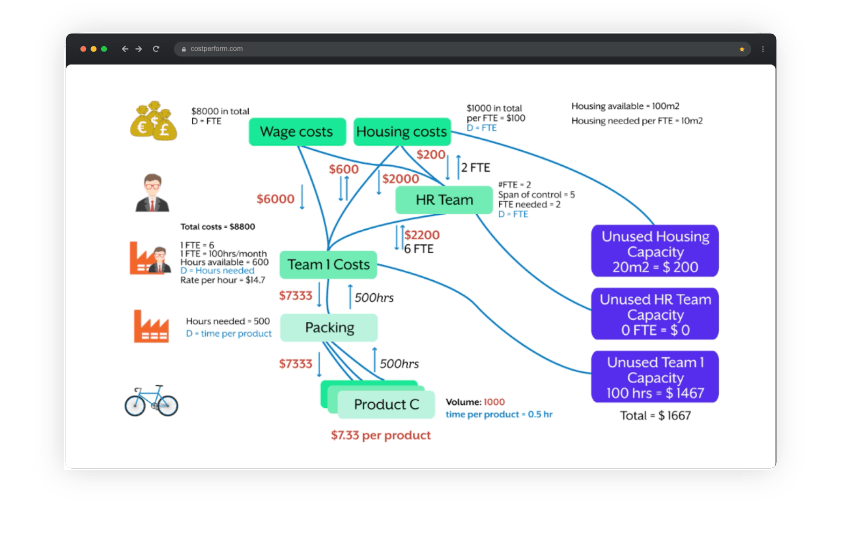Time-driven Activity-Based Costing (TDABC) by CostPerform
Make activities more efficient and effective with TDABC
Every company and organization has activities that can be identified, measured and thus improved for better business performance. By using Time-driven Activity-Based Costing as a costing method, you can open up the way to variance analysis and capacity management for making activities more efficient and effective, and thus influence unit costs, cost prices and profits.
What is Time-driven Activity-Based Costing?
As the name suggests, TDABC is a time-driven variant of the traditional Activity-Based Costing method. These are the most significant differences between the two:
Time-driven Activity-Based Costing
- A form of pull cost modelling that uses a dynamic cost driver, in this case, the time needed per unit or activity. It’s dynamic because it adapts to the volume produced;
- In pull costing, costs are pulled up from products or services to cost centres, based on demand.
Activity-Based Costing
- A form of push cost modelling that uses a static cost driver, in this case, the time spent per unit or activity. It’s static because it doesn’t adapt to the volume produced;
- In push costing, costs are pushed down from cost centres to products or services, based on estimates or measures.
This is how Time-driven Activity-Based Costing works
While an Activity-Based Costing or push model can best be compared to a waterfall where costs only flow down, a Time-driven Activity-Based Costing or pull model looks like a two-directional water system. Here, costs can flow up and down thanks to the use of a dynamic cost driver (the time needed per unit or activity) that adapts to the volume produced. This is how Time-driven Activity-Based Costing works compared to ABC.
Most important Time-driven Activity-Based Costing features

Create activity-based budgeting, forecasting and simulations

Using CostPerform’s building block principle can lead to tremendous insights

Create true cause-and-effect relationships between products and costs

Understand and visualize the metrics that are important for your business
This is what Time-driven Activity-Based Costing does
In short, Time-driven Activity-Based Costing lets you calculate the cost price of a product or service with a dynamic cost driver that adapts to the volume produced, in this case, the time needed per unit or activity. With TDABC, and compared to ABC, this results in a more realistic cost price and, more importantly, insights into the true cause-and-effect relationships between time, volume and cost price. This allows you to assess the effectiveness and efficiency of cost model components, discover where improvement is needed and thus directly impact unit costs, cost prices and profits.
For instance: as you can see in the example below, Team 1 has an unused capacity of 100 hours, costing 1467 dollars. To make the team more profitable, it looks like there are two options: lose 1 FTE or increase the production volume to 1200. With CostPerform and Time-driven Activity-Based Costing, you can map out the consequences of both solutions and see which one is best for your business.

Advantages of Time-driven Activity-Based Costing
This is why TDABC (pull) always beats ABC (push) by knockout:
- TDABC is more realistic than ABC thanks to better cause and effect relationships;
- TDABC also gives insights into capacity and usage, enabling capacity management;
- By adding volume to the cost model, TDABC makes scenario analysis possible;
- TDABC also enables variance analysis, making it possible to continuously improve your time standards, capacity usage and future budget models.
Time-driven Activity-Based Costing allows you to assess the effectiveness and efficiency of cost model components and discover where improvement is needed.
CostPerform Time-driven Activity-Based Costing in short
Time-driven Activity-Based Costing is a form of pull cost modelling that can be implemented in your cost model as a method to calculate cost prices. Thanks to time as a dynamic cost driver, true cause-and-effect relationships between products and costs become visible, providing insights that can be used to assess the effectiveness and efficiency of cost model components. This way you can discover where improvement is needed and impact unit costs, cost prices and profits for better business performance.
Request a demo
Fill in the form below and we will reach out to you to plan an online demo of our cost management software.